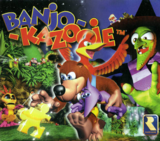Banjo Kazooie is still a great game, but it's hard to deny that portions of it haven't aged well.
Cons: Certain gameplay elements haven't aged so gracefully; Sounds can be pretty annoying at times; Way too much collecting
When reviewing a game from one's past, avoiding bias can be difficult. Thus presents my challenge reviewing Banjo Kazooie: taking everything into consideration so as to give an honest critique for the uninformed player. Luckily, the base of the game still holds up after all of these years. It's the details that haven't kept together so well.
Although I'm sure most of you will have heard or remembered something about Banjo Kazooie, for those unaware, this is a game about a bear (Banjo) and a bird (Kazooie) who go on a quest to rescue Banjo's little sister from the evil witch Gruntilda. The plot keeps pretty simple and lighthearted, much to its advantage, although some of the dialogue feels forced and unfunny.
Nonetheless you are soon out to collect everything in sight. And by everything, I mean EVERYTHING. You will collect jiggies (jigsaw pieces required to move on. There are 100 of these to keep you playing for a while), music notes (also required to move on), Mumbo skulls (required to transform, more on this later), Jingos (weird bird-like creatures; optional, but recommended), and much more.
So, no, there isn't a whole lot of objective variety, and things certainly get repetitive the further you go on. Luckily, varied levels and solid mechanics help you trudge through. The basic gameplay is the simple jump and attack mechanics that are standard in the platforming genre, but the game knows when to throw in a twist to keep you engaged.
The most notable twist is the transformations. In almost every level you can find Mumbo (a shaman)'s hut and he will transform you into some other creature ranging from an ant to a walrus, to a…pumpkin? These transformations vary in quality, but they all contribute to breaking the pattern and are much appreciated. The levels are also remarkably varied. No two levels are mistakable for one another and some of them are even pretty creative by today's standards (see the late-game season changing level).
However, therein lies the game's biggest downfall: it's dated enough that much of it fails to impress "by today's standards." The camera for instance, just doesn't work as well as it should always, and the controls for it feel limited. Furthermore there are times when clues are vague and the designers must have wanted you to try every possible task with no hints whatsoever (which is a design feature that doesn't show up nearly as often thankfully).
Also aging have been the graphics, which thankfully are still good enough to do the job, not to mention remind you of how far graphics have come (remember when these blocky shapes and textures used to be top of the line?). Although the game has received a facelift, it is nothing substantial, which is actually kind of a good thing in this case. The sound…well the sound wasn't particularly great in the first place; it's actually kind of annoying minus the occasional good music item.
It's a little bit hard to recommend Banjo Kazooie to the newcomer who has never played an N64 or PlayStation game of the time, because it certainly has its flaws. But for that generation of gamers who would like to look back on good memories, at $15 Banjo Kazooie definitely warrants a download.

